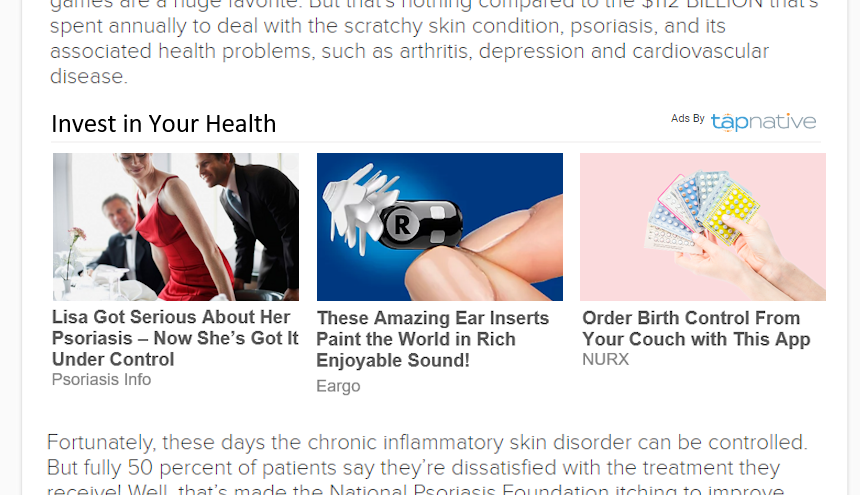|
Text to speech plug in test
|
The Bufferfly Effect is a phenomenon whereby smaller, minute changes in an environment can create massive changes. Several health-focused companies have found real traction using technology to harness the winds of change to harness supply or demand.
Let’s start with the demand.
Tap Native (also referred to as ‘Tap’) is a native ad platform and content recommendation engine laser-focused on health and medicine – it’s this focus that has taken the digital health vertical by storm. By now, we’re all familiar with the often bizarre content style ad tiles feature within editorial content – providers like Outbrain and Taboola made these formats popular almost a decade ago. What Tap’s founders realized is that no credible health publisher would dare feature those types of ads because they degrade what should be a sober, serious and credible experience. Having worked with some of the top health publishers and advertisers at various points in their 20+ years in digital advertising, Tap’s founders understood that health publishers and marketers are more sensitive to content and brand adjacency issues. Credibility and trust are far more important on health and medical sites, and the AdTech marketplace simply overlooked that. Tap Native was born in late 2018 and within three months, had been adopted by over 100 health and medical sites including many top tier players like Drugs.com, Sharecare.com, Familydoctor.org and Healthday.com. Tap’s cofounder, R.J. Lewis, explained it like this:
“Audiences researching health topics are far more valuable than audiences on news, political or fashion sites. Generic ad providers don’t focus on health and they certainly don’t focus on selling into dozens of specialized therapeutics within the health vertical but that’s all we do, and we’ve been doing it for over 20 years, so we make each of those ad impressions look better and pay better.”
Tap Native generates a significant new revenue stream for health publishers by utilizing sections of their site that traditionally yielded little or no revenue in the past and didn’t work well for display ads. For those publishers, Tap’s new revenue has added millions to their bottom line and opened a universe of new monetization, sponsorship, analytic and traffic driving possibilities.
The “Uberization” of Healthcare
Patients, especially digital savvy ones, expect instant access to a full spectrum of health-related products and services online. This uberization is the effect of consumers taking a far greater role in their own healthcare. In turn, healthcare marketers have become far more patient-centric in how they deliver products and services, and part of this means contextual targeting. This dynamic is the result of more and better conversions through contextual placements as well as a growing reluctance to use 1st or 3rd party cookies, especially around sensitive therapeutic topics like cancer, sexual health, mental health and others. Other changes include healthcare marketers’ steady beliefs that content marketing will make one of the largest commercial impacts ever. Native ads reach users who are often resistant to banners because they are not branded and placed within editorial content unlike that of traditional ad spots like the right rail.
These trends have inspired Tap Native to launch Drug & Condition Match Targeting in late 2019 – a relational keyword database of over 21,000 Rx and OTC drug names classified by therapeutic, drug class, condition and other dimensions. The interface enables healthcare marketers who are not medical experts to target pages with more granularity. Lewis explains it like this:
“If you’re marketing a product for diabetics, you might have chosen to target your ad on pages that contain keywords like diabetes or diabetics. There might be 100 million pages that contain one of those keywords, but the word itself doesn’t indicate user intent for seeking treatment or even mean the user viewing the page has diabetes. With our tool, you can start to narrow your targets to reach audiences with far greater intent. The best pages contain the names of drugs, drug classes or products used to treat diabetes – these are the pages you want your ad on, and this is what our interface helps health marketers do.”
Tap Native now works with hundreds of health marketers including hospitals, consumer products, medical devices and wellness services. Tap Native has also been a pioneer in pharmaceutical native advertising.

Enter Facty.com
The supply side of health publishing is changing too but as always, health sites are a dime a dozen. What most sites lack, however, is a rich library of credible, vetted content. Of course, getting people to visit your site is the hardest part of the equation but a new species of digital publishers has emerged. Facty.com (Facty) uses technology to arbitrage traffic sources efficiently and at scale. Facty has built an incredibly rich and diverse library of content across dozens of therapeutics checked by medical professionals. Facty also has something most other health sites don’t have: tens of millions of monthly visitors seeking answers to important health questions.
Facty, owned by Redbrick, is now one of the fastest growing digital health publishers because it uses cutting-edge technology to intelligently engage audiences at the source, such as search engines, social, and various display channels. Facty uses both organic and paid sources to engage audiences across a full range of therapeutic categories by understanding intent at the keyword and source level. Facty measures how much it costs to acquire users and what they earn on the backend. Facty has been so successful that it now sees over 20 million unique users monthly, making it a top tier health destination in a small group that includes, WebMD, Healthline and Everyday Health.
Supply and demand – a beautiful synergy
Facty has mastered the art of health content creation and finding profitable, scalable methods of driving health information seekers via the use of technology and data. On the supply side, Facty has cracked the code. On the demand side, Tap Native has mastered the art of enabling marketers to tap specific content pages that reach users with higher intent and help health publishers monetize portions of their site they were never able to before.
It’s no surprise, then, that Facty and Tap Native recently announced a three-year deal to increase Facty’s native ad quality, relevance, engagement and revenue. Facty will receive access to Tap Native’s tools for health publishers like health-focused analytics, internal recirculation, a health-focused traffic exchange, emailable ad units and the ability to call indirect and programmatic advertisements from Tap Native’s contextual demand sources. Jamie Geiger, Director of Advertising Operations at Assembly had this to say about the partnership:
“We chose Tap Native to increase the relevance and value of the native ads on our site. We’re also looking forward to promoting our content in Tap’s health focused traffic exchange to introduce Facty’s brand and content to millions of additional health information seekers.”
With the amount of information available on the Web, capturing consumer attention requires relevant content and a strategy to drive targeted users at scale. It takes intelligent technology and revenue models to know how and where to profitably deliver those messages across a complex and ever-changing digital eco-system. It also takes near real-time analytics to make those interactions economically viable to both the supply and demand sides of the digital health business. Tap Native and Facty are two great examples of companies resetting their sails to capture the changing winds of digital healthcare.



![6 Digital Tools at the Center of Healthcare Digitalization [INFOGRAPHIC]](http://ec2-54-175-84-28.compute-1.amazonaws.com/pharma-mkting.com/wp-content/uploads/2021/04/6DigitalTools_600px-218x150.jpg)




![6 Digital Tools at the Center of Healthcare Digitalization [INFOGRAPHIC]](http://ec2-54-175-84-28.compute-1.amazonaws.com/pharma-mkting.com/wp-content/uploads/2021/04/6DigitalTools_600px-100x70.jpg)




